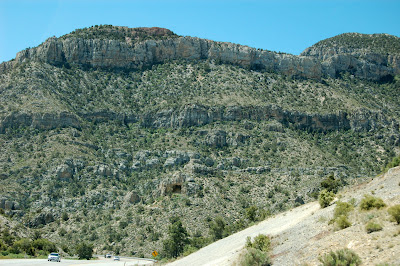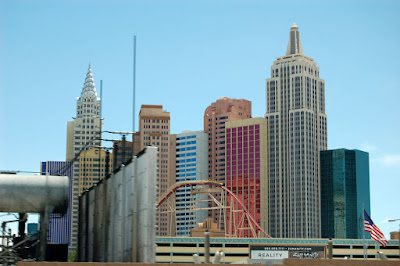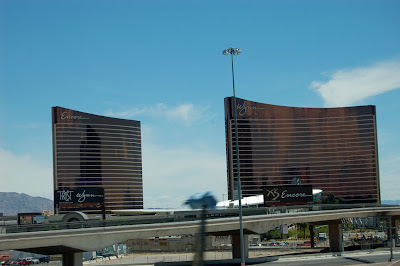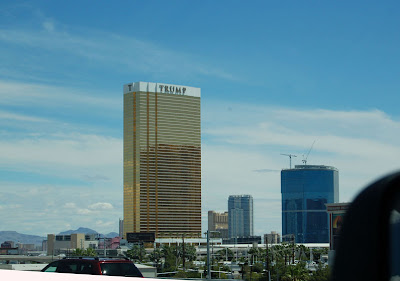
Destination--Las Vegas. We entered from the south via I15, and due to construction and a fender bender, had time to view the new(er) buildings on the Strip. A woman I talked to in Pahrump told me she grew up in Vegas and that during her childhood it looked pretty much like Pahrump does today. The difference is, of course, investment money and the all important location.
 The weather was very cooperative, partly cloudy and cool. Soon after, though, the temp went back to usual for this time of year--80's day, upper 60's lower 70's night. Wonderful!
The weather was very cooperative, partly cloudy and cool. Soon after, though, the temp went back to usual for this time of year--80's day, upper 60's lower 70's night. Wonderful!
New York, New York

Steve Wynn's babies--Wynn and Encore

Trump Tower
 Las Vegas gives new meaning to the term 'urban sprawl'. It stretches for miles in all directions. The famous downtown stip is a very small part of town. We continued on north to Las Vegas Blvd. at Lamb and the Hitching Post RV Park. This park is a Good Sam's park. It forms a complex with the hotel and restaurant next door. The park is nice with packed gravel pull-thru parking, medium sized lots that accomodated us with a ease. Each lot has a picnic table, too. There is a nice, large, salt (no chlorine) pool. I love it, cause it is just cool enough to keep most people out. At this time of year there are no kids, either, so I usually have it to myself! Entry to the pool is through mens or womens restroom/showers. These are very nice with several stalls, sinks, and showers. There is a dog play area and a nice laundry all for the bargain price of $31 per night. Across the street runs the bus. For $5 you can get a 24 hour all transfer ticket, unless you are over 60. Then it will cost you $2. We figure its the way to go to the strip. When we arrived and got set up, we took the rest of the day off. Friday we packed our cooler and headed south to Lake Mead and Hoover Dam. (Sorry for the dearth of pix, but we went out without our big camera, and the little one only had 1/2 battery!)
Las Vegas gives new meaning to the term 'urban sprawl'. It stretches for miles in all directions. The famous downtown stip is a very small part of town. We continued on north to Las Vegas Blvd. at Lamb and the Hitching Post RV Park. This park is a Good Sam's park. It forms a complex with the hotel and restaurant next door. The park is nice with packed gravel pull-thru parking, medium sized lots that accomodated us with a ease. Each lot has a picnic table, too. There is a nice, large, salt (no chlorine) pool. I love it, cause it is just cool enough to keep most people out. At this time of year there are no kids, either, so I usually have it to myself! Entry to the pool is through mens or womens restroom/showers. These are very nice with several stalls, sinks, and showers. There is a dog play area and a nice laundry all for the bargain price of $31 per night. Across the street runs the bus. For $5 you can get a 24 hour all transfer ticket, unless you are over 60. Then it will cost you $2. We figure its the way to go to the strip. When we arrived and got set up, we took the rest of the day off. Friday we packed our cooler and headed south to Lake Mead and Hoover Dam. (Sorry for the dearth of pix, but we went out without our big camera, and the little one only had 1/2 battery!)
We went a little unprepared for the crowds, traffic, and small places, but soon figured it out. We followed the signs through the pretty little town of Boulder City, the town the dam built. (Note to friends Marsha and Paul--you will love exploring this little town.) When you get to the dam area, you can choose to drive past or turn into the canyon. Once you are there, the road funnels you into the parking garage ($7). It was tight for us (dual wheels, 24') but doable. The floor is so clean everyone squeals their tires! From there you turn right for the outdoor cafe and gift shop, straight ahead for a view, or left and down the steps to the new visitors center. Once you enter the door be prepared. Thanks to 9/11 all visitors must pass through inspection centers, just like the airport. All bags, electronic devices, metal objects go through the xray and you go through the little doorway. Absolutely no pocket knives or multitools, but you don't have to take off your shoes. Once through, there is no place to go but the turnstyles where you pay to get in. For the full tour--$30, for the power plant tour--$11, to tour the visitors center--$8. With your tour you get a very nice 58 page book chock full of information and pictures about the making of the dam. We were going on the full tour, but had 2 1/2 hour wait so opted for the power plant tour. Being over 62 saved us a $2 each, since she took Duane's word for it that I was 62 too. If you have a passport, here is where you get a stamp. It isn't a regular dated stamp, but has a picture of the dam, so I counted it good enough. I found a pressed penny machine in the gift shop, if you're interested. From the turnstyles you find yourself in a line that gets your picture taken, then you enter an open area. If you paid your $8 you look around here and at all the outside exhibits and viewpoints. If you opted not to pay, you can stop at the bridge walk on the AZ side and walk up the steps to the top of the dam and view the outdoor exhibits. You can drive across too, but the road is narrow and crowded and you can't really see anything. If you take a tour, you go into a theater to view a short film on the making of the dam. Then you enter elevators that take you below to one of the power plants. From there you go to where the turbines are housed, directly in front of the dam. Well informed group leaders give you lots of information on the dam, answer all your questions, and keep you moving. We decided that we understood how cattle felt in the chute, so occasionally we would let out a mooo. After the tour we were free to wander around wherever.

Turbines. The water runs the turbines, which generate electricity.

Dam with Lake Mead behind it.

View of the Colorado River from dam. You can see the new bridge build in response to 9/11.


View from top of dam, Lake Mead. Note the Black Canyon (actual name of the canyon) walls. NV is on the left, AZ on the right.

Colorado River from the top of the dam.

Self portrait. It was cheaper than the one taken inside the visitors center upon our arrival.

For fun we walked the dam to AZ and back again. View from the dam of the new visitors center.

Sculpture--High Scaler

Part of Lake Mead as seen from the Lakeview Overlook on Lakeshore Dr. From the dam parking lot we backtracked our way to this road. This is part of the Lake Mead National Recreation Area, so once again our National Parks pass came into play and got us free admission. The visitors center was closed for renovations, so I didn't get a stamp. This is the first viewpoint if you are coming from the dam. We ate lunch here.

Same view, to the right.

Different view, further north. Notice that all around the lake is desert.

Late afternoon view of Las Vegas from the east.

From our tour and our nice booklet, we learned that in 1902 Pres. T Roosevelt signed the Reclamation act, creating the US Reclamation service, now the Bureau of Reclamation. Reclamation engineers could now begin there long series of investigations and reports on control and use of the Colorado River. In 1905-07 The river broke into Imperial Valley and flowed into the Salton Sink for 16 months, causing extensive damage and creating the modern Salton Sea.
On 1918 after years of study and reports, the Relcamation director and chief engineer proposed the control of the river by a dam of unprecedented height in Boulder Canyon on the AZ-NV border. In 1919 the All-American Canal board recommended the construction of the All-American Canal. This 85-mile long canal would bring water from the river to the Imperial Valley. It would replace the former canal, which served the same funcion, but traveled partly through Mexico. In 1922 the recommendation to build these structures was introduced to congress. The CO River Compact negotiated by Secretary of Commerce Herbert Hoover and the seven basin states, divided the use of the river water between upper and lower basins. It wasn't until 1928 that the Boulder Canyon Project Act authorizing the construction of the two structures passed the Senate and House and was signed by Pres. Calvin Coolidge. In 1931 the Bureau of Reclamation awarded the construction contract to Six Companies--the name of the company formed by, well, 6 companies. In 1932 the river was diverted around the dam's construction site. In 1933 the first concrete was poured. In 1934 the All-American Canal construction began. In 1935 the dam started impounding water in Lake Mead and the last concrete was placed on the dam. in 1936 the first power was generated. In 1940 the All-American Canal was placed in operation. From 1941-45 the dam was closed to the public for the duration of WWII. In 1947 it was officially named Hoover Dam in honor of President Herbert Hoover. There was much more timeline and lots of information about the capacity of Lake Mead, the number of visitors, how the water actually generates electricity and how much, how the water is apportioned among the states and Mexico, how Boulder City was built for the workers etc., but that's prolly enough for now. In spite of some preliminary confusion and diffculty on our part, we enjoyed ourselves and think the tour was well worth it.
Time for a rest,
Louise and Duane

1 comment:
We really enjoyed the dam tour when we were there. I love all those dam saying from the movie...hee hee. Great self-portrait. You need to do more of those.
Louise...you and I know our real age. But to save a couple of bucks...what the heck.
We will be using your blogs are our tour guide when we are out that way.
Thanks for the good times.
Post a Comment